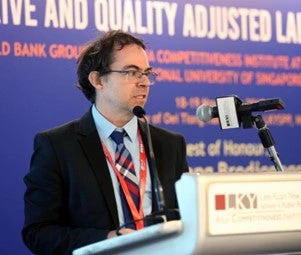
If history is any guide, this growth in urban population will provide tremendous opportunities for increasing prosperity and livability. One can look at the successes of a few Asian cities such as Tokyo, Seoul, and Singapore to demonstrate how, with the assistance of good policies, urbanization and economic development go hand-in-hand. More generally, no major country has ever reached middle-income status without also experiencing substantial urbanization.
Yet cities can grow in different ways that will affect their competitiveness, livability, and sustainability. The more successful cities of Asia have been effective at creating opportunities, increasing productivity, fostering innovation, providing efficient and affordable services for residents, and enhancing public spaces to create vibrant and attractive places to live. But many, many, more cities have neglected fundamental investments in critical infrastructure and basic services, and have mismanaged land, environmental and social policies. This has resulted in traffic congestion, sprawl, slums, pollution, and crime.
Among the many complexities of urban development that have contributed to success, two critical factors stand out – investing in strategic urban planning, and in good urban governance.
The growth of Asian cities has involved substantial land expansion. In South Asia, urban land area is projected to more than double between 2010 and 2050. In the next decade alone, China plans to build additional urban space equivalent to ten times that of the area of New York City. The contrast is stark between those cities that have planned for this expansion by building roads and providing public transport, basic services, and affordable housing, and those that have not made such investments. The traffic congestion in cities such as Delhi, Dhaka, Jakarta, and Manila are notorious, as are the slums and pollution. From a sample of 381 developing country cities in 2014, 19 out of the 20 cities that recorded the highest levels of air pollution were from South Asia.
Such conditions are avoidable through strategic planning for urban expansion. There are many tools used by urban planners that can anticipate and plan for such growth through better land use, but very few Asian cities have done so. Even worse, in many Asian countries and cities, planning practices have had the unintentional effect of encouraging low-density sprawl and exacerbating the shortage of affordable housing.
As in much of the rest of the developing world, the lack of good urban planning is in part due to governance and politics. Good governance for cities involves decision-making supported both nationally, and, especially in large metropolitan regions, across city level administrative boundaries. Many national level governments do not see investments in cities as a priority for development or even in conflict with political constituencies. Sufficient funding is not made available from national budgets, and projects take a short-term perspective, looking for quick wins. And a lack of resources inevitably tends to be accompanied by a lack of empowerment of urban governments. Although cities such as Surabaya in Indonesia have benefited from devolution of both powers and resources to the local level, they are exceptions that tend to prove the rule.
Within cities, the complex institutional and administrative arrangements make it very difficult to coordinate across jurisdictional boundaries. Take, for example, the Manila urban area, which includes 85 municipalities and cities over 7 provinces. Planning for transport, disaster risk management, and climate change across the metropolitan area requires a broad spatial perspective and much coordination. Yet such efforts can become embroiled in a multitude of interjurisdictional regulations, politics, and lack of incentives.
Investments in the cities of today is essential for the future. Once built, a city’s structure cannot be easily reshaped. The lack of planning for future expansion will result in huge inefficiencies that will take enormous resources and many decades to fix.
Strategic urban planning and management through good governance can help to avoid unnecessary sprawl, plan for expansion, help to reduce inequality in access to urban opportunities and amenities, and prioritize a low carbon growth model. Urban planning that links up jobs, affordable retail, public transport, health and education services, and affordable housing is how the successful and prosperous cities of Asia have done it. Now it’s time for others to do the same.
Learn more:





Join the Conversation